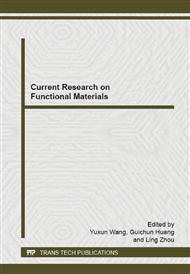p.438
p.444
p.450
p.456
p.461
p.466
p.473
p.482
p.489
The Influence of Additives on Hydroxyapatite Biological Coatings of Titanium Alloy Substrate
Abstract:
In this paper, the biological coatings were studied by adding different kinds of additives (TiO2, Al2O3 and ZnO) to hydroxyapatite (HA). The different mass ratio of additives and HA in suspension was mixed with n-butyl alcohol as solvent, triethanolamine as dispersant. The HA composite coatings with additives on titanium alloy substrate were prepared by the method of electrophoretic deposition (EPD). The coatings were characterized by scanning electron microscopy (SEM), Ca/P atomic ratio in composite coatings was analyzed by Energy Dispersive Spectrometer (EDS). The results showed that surface of HA coatings was more uniform and dense by adding TiO2 than Al2O3 or ZnO; and when adding the same kind of additive, the content was higher, there were more holes in HA coatings and surface of the coatings was less uniform. When HA was 15 g/L and TiO2 was 5 g/L in suspension, Ca/P atomic ratio was 1.56, that’s the most close to the body's natural bone (~ 1.61). HA coatings can be implanted in the body after a short time of ossification and exhibited a good bioactivity.
Info:
Periodical:
Pages:
461-465
Citation:
Online since:
October 2014
Authors:
Keywords:
Price:
Сopyright:
© 2014 Trans Tech Publications Ltd. All Rights Reserved
Share:
Citation:


